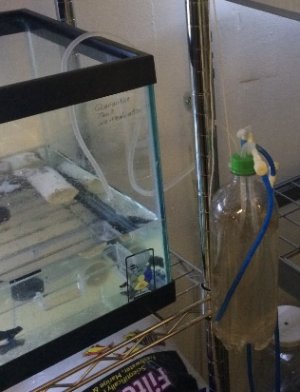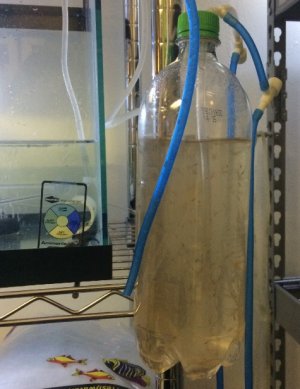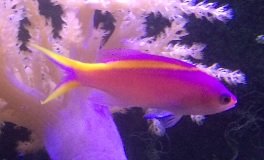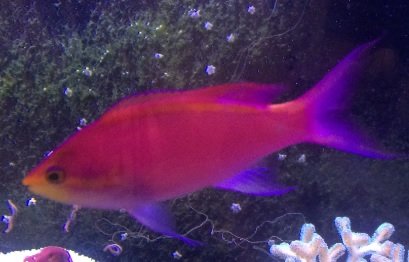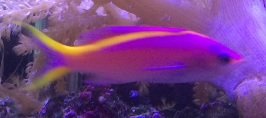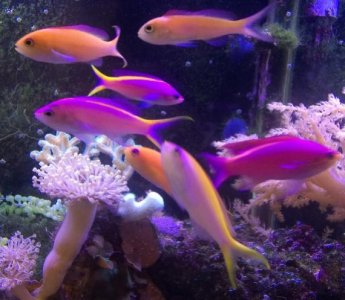Hey guys. Just checking in with an update. Of the three purple queens I had, it turned out that two of the ones I had were tukas, and one was a pascalus. Unfortunately I've come to learn that these fish do not do well at all with being the only one of their kind in odd numbers. My pascalus died due to stress as, when it was just one tuka and one pascalus, they were doing fine, but, when I got a second tuka, the pascalus stopped eating much at all. For months it only would eat one or two pieces of brine at most, but no more than that. Eventually it became emaciated and then disappeared (missing for two weeks now, so, pretty much a goner).
My two tukas are doing very well though, both eating very aggresively and have become rather plump. I have started mixing pellet food into my frozen mix, letting the the pellets sit in a mix of the frozen food mixed with tank water in the fridge for a half a day to a day, and feeding it to my tank, and, the tuka are now beginning to eat and swallow the pellets along with the frozen.
The larger of the two tuka is beginning to turn to a male I believe (upper part of it's beak is beginning to turn a very vibrant yellow, it's two front lower fins are beginning to become more pointed, and, on it's dorsal fin, there is a transparent line at the back half of the dorsal fin, as if it's dividing the two sections of color on it's fin).
A couple of things I noticed that really seemed to help with these fish:
They love flow. They had been eating well for some time, but, I added another two powerheads to my tank, and adjusted them to alternate (where, if I feed the middle of the tank, the food will get swept all the way to the left of the tank, then, food will get swept all the way to the right of the tank, a repeated alternating cycle). After adding these, the fish seemed to start eating much more aggressively, where, the second the food hits the water now, the two tukas are there immediately, taking all of the best pieces before the other fish even get there.
For whatever reason, these fish seem to alternate on the types of foods that they want to eat. They'll be eating brine for weeks at a time and seem to only want the gut loaded brine, then, all of a sudden they'll stop eating the brine and will only eat minced prawn. They'll do this for a week and will stop eating prawn and go back to eating brine and minced clam. I usually feed a mix of food at all times, so this isn't a problem, but, something to keep in mind.
Also, frequent feedings don't seem to be necessary, but, it does help. What I currently do is feed in the morning, then, when I get home from work, I'll thaw out some mixed frozen food and leave it at the tank, then, for the rest of the afternoon, whenever I or my wife pass the tank, we just add a little food from the thawed frozen mix. This gets the fish fed a little at a time every hour to hour and a half for the rest of the night. Every time the fish eat aggressively.
I've tried a number of different foods for the fish at this point, and, for the most part, of the two that I have, once they begin eating frozen, the ones I have seem to like/dislike:
Will eat this aggresively: SFB Reef Plankton, minced prawn (minced to ~1-2mm), hikari krill (shaved with a knife to 0.5-2mm pieces), finely minced clam (~1-2mm), finely minced amphipods (hikari gammarus) (minced to ~1-2mm), reef nutrition arctic pods, fresh live adult brine shrimp (in clean tank water), live tigger pods.
Will eat this, but not as aggressively: gut loaded brine, hikari mysis, PE mysis, PE calanus, SFB Cyclops, frozen (non-live) tigger pods, brightwell aquatics zooplanktos (rinsed with tank water).
Will not eat this (will spit this out): bloodworms, daphnia, cyclopeze, reef nutrition beta brine, rod's food fish eggs, live amphipods (even smaller ones).
On a side, note, the original live baby brine shrimp feeder I had is still running and feeding baby brine, but, neither of the tukas eat the baby brine anymore. All the other fish do, but, the two tukas seem to have no interest in the baby brine.


